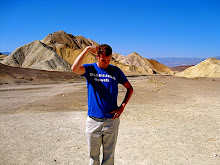This quarter of the year it seems to be a common occurrence to find myself surveying in the South Pacific. After my first exposure to the area, coupled with my ancestral background and interest, I have found it to be the part of the world I enjoy visiting most. The beginning of my trip leads off with New Zealand, the country where my grandmother on my mother's side originates from. Although New Zealand is most commonly known for geographic isolation, sheep and the Lord of the Rings, to me it is a country of cultural heritage for my family.
Wellington Cable Car
New Zealand is one of the most recently settled major land masses, with a history even younger than the United States. New Zealand was settled by eastern polynesians 1000s of years ago, much like the North American Indians, but wasn't settled by westerners until the 18th century. At this time, there was an abundance of aboriginies living there, known as Maori's. The European settler's began to come in droves and after a short while, outnumbered the local people. After many disputes, they signed a treaty giving Maori's rights, but they have developed into a minority in New Zealand.
Due to the arrival of Westerners, the Maori culture was affected tremendously, similarly to many other indigenous people all over the world in the persistent forcing of Christianity upon them. The introduction to weapons and new diseases to their society is a major cause in their decline in population after the arrival of Europeans. In the past 50 years, the Maori culture has experienced a great revival due to agreed western assimilation and the introduction of education and some progressive Maori politicians. Now there are designated seats in the NZ Parliament and considerations and consultations with Maori officials have become the norm for government organizations.
Despite these social and economic advances, Maori still register low percentiles on many health and education statistics, as well as labour force participation. They register high in criminal and imprisonment figures and like many indigenous cultures, are affected deeply by institutional and direct racism.
Maori culture is probably most well known for
Ta Moko which is the permanent body and face markings that they seem to be heavily covered in. It differs from common tattoo art in that it is done with chisels, rather than punctured by a needle, leaving the skin with grooves, rather than a smooth surface. In the early years of Maori culture, it was a symbol of power or social status and they were received ritually to show passages into adulthood. This form of art has popularized in recent times, and Maori tattoos can be commonly seen on people who have no affiliation with the culture.
Maori Ta Moko
The
Te Papa museum in Wellington is a wonderful place to check out information on Maori history and heritage, as well as all of New Zealand.
Later this week, my coworker and I are taking a ferry over to the South Island and renting a car to drive from tip to tip. Passing through the west coast, Fox and Franz Josef Glacier and heading down to Fjordland National Park to check out Doubtful Sound and Milford Sound. Some links below on where we're headed, pictures soon to come.
Franz Josef Glacier - Glacier frontier with hiking, skydiving and tons of open space
Doubtful Sound - Cruise around Fjordland
West Coast - Lonely Planet rated this one of the top 10 coastal drives in the world




































